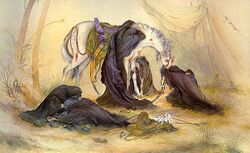Day of Ashura'
| Mourning of Muharram |
|---|
 |
| Events |
| Figures |
| Places |
| Occasions |
| Rituals |
| Islam |
|---|
 |
The day of ʿĀshūrāʾ (Arabic: عاشوراء) is the 10th day of Muharram in Lunar Hijri calendar. This day is important for Shi'a due to what took place in Karbala on this day in 61/October 10, 680). On that day, Imam al-Husayn (a) and his companions were martyred in the battle with the Kufian army led by Umar b. Sa'd.
Every year as the month of Muharram arrives, Shi'a around the world hold sessions of mourning for Imam al-Husayn (a), which usually continue to the 11th or 12th of Muharram and, in some regions, to the end of the month of Safar. The day of Ashura is the peak of the mourning and is an official holiday in Iran, Iraq, Afghanistan, Pakistan, and India.
Lexicology
According to the majority of lexicologists, the words "'Ashur", "'Ashura" and "'Ashura'" is the name of the 10th of Muharram. Some added that, etymologically, 'Ashura' is a Hebrew word changed to 'Ashur in Arabic. In Hebrew, it is the name of the 10th of Tishri (the first month in the Jewish calendar).[1]
Before Islam
Jews, Christians and Arabs of Ignorance Era honored the day of 'Ashura and fasted on this day.[2] In al-Misbah al-munir, al-Fayyumi has narrated from the Prophet (s), "Fast a day before and a day after 'Ashura so that you would not be similar to Jews, who fast the 10th only."[3] Similar hadiths like this have been narrated in Sunan al-Darimi, Sunan Ibn Maja, Sahih Muslim, Jamharat al-lugha, Sahih al-Bukhrai and Nayl al-awtar.[4]
Before the Battle of Karbala

Al-Shaykh al-Saduq has narrated in his book Man la yahduruh al-faqih form Imam al-Baqir (a), "Fasting on the day of 'Ashura was common before the compulsion of fasting during the month of Ramadan, but it was left after that."[5]
Sunnis believe that 'Ashura is the day when Moses split the sea and passed it along with his companions. They honor this day and believe that fasting on this day is Mustahab (recommended).
After the Battle of Karbala
The tragedy of Karbala took place on the 10th of Muharram of 61. Imam al-Husayn (a) was 56 on that time.[6]
After the Battle of Karbala, Banu Umayya (the Umayyads) regarded this day as a blessed day by storing their annual food supplies, congratulating each other, wearing new clothes, and fasting; as it is said in Ziyarat al-'Ashura: "O Allah, this day has been regarded as a blessed day by Banu Umayya".
Imams of the Shi'a have ordered not to fast during 'Ashura. They advised Shi'a not to eat or drink except for a small amount before sunset so it would not be terminological fasting.[7]
Mourning

Shi'a, some Sunnis, and even some adherents of other religions mourn for Imam al-Husayn (a) and his companions on the day of 'Ashura. At the beginning reading poems about the martyrs of Karbala and weeping was the only part of the mourning sessions; but gradually Maddahi, Rawda Khani, Shamayil Kishi, Sina Zani, Ta'ziya and other traditions, most of which formed during Buyid, Safavid, and Qajar dynasties. However, some great Shi'a scholars opposed some of these traditions, especially tatbir.
Recommended Practices
Shaykh 'Abbas Qummi says in Mafatih al-jinan, "It is recommended that the person not do worldly affairs on this day; he should be upset and the sorrow should appear in his clothes and food. He should mourn for Imam al-Husayn (a) on this day and visit the Holy Shrine of Imam al-Husayn (a) and read Ziyara text of Imam al-Husayn (a) on this day (Ziyarat al-'Ashura)".
Also, reciting the al-'Asharat supplication, reciting Surat al-Tawhid for one thousand times, not eating and drinking without having the intention of fasting, and cursing the murderers of Sayyid al-Shuhada' for one thousand times, has been reported among the practices of this day.[8]
See Also
Notes
- ↑ Group of authors, Dā’irat al-maʿārif tashayyuʿ, vol. 11, p. 15.
- ↑ Ustādī, Pīshīna-yi ʿāshūrā, p. 38-39.
- ↑ Ustādī, Pīshīna-yi ʿāshūrā, p. 38-39.
- ↑ Ustādī, Pīshīna-yi ʿāshūrā, p. 37-38.
- ↑ Ṣadūq, Man lā yaḥḍuruh al-faqīh, vol. 2, p. 85.
- ↑ Iṣfahānī, Maqātil al-ṭālibīyyīn, p. 84.
- ↑ Ustādī, Pīshīna-yi ʿāshūrā, p. 42.
- ↑ Qummī, Mafātīḥ al-jinān, p. 288-289.
References
- Group of authors. Dāʾirat al-maʿārif tashayyuʿ. Tehran: Muʾassisa-yi Intishārāti-yi Ḥikmat, 1390 Sh.
- Iṣfahānī, ʿAlī b. al-Ḥusayn al-. Maqātil al-ṭālibīyyīn. Beirut: Muʾassisat al-Aʿlamī li-l-Maṭbūʿāt, [n.d].
- Qummī, ʿAbbās. Mafātīḥ al-jinān. Qom: Uswa, [n.d].
- Ṣadūq, Muḥammad b. ʿAlī al-. Man lā yaḥḍuruh al-faqīh. Tehran: Nashr-i Ṣadūq, 1367 Sh.
- Ustādī, Riḍā. Pīshīna-yi ʿāshūrā. Qom: Zamzam-i Hidāyat, 1387 Sh.

